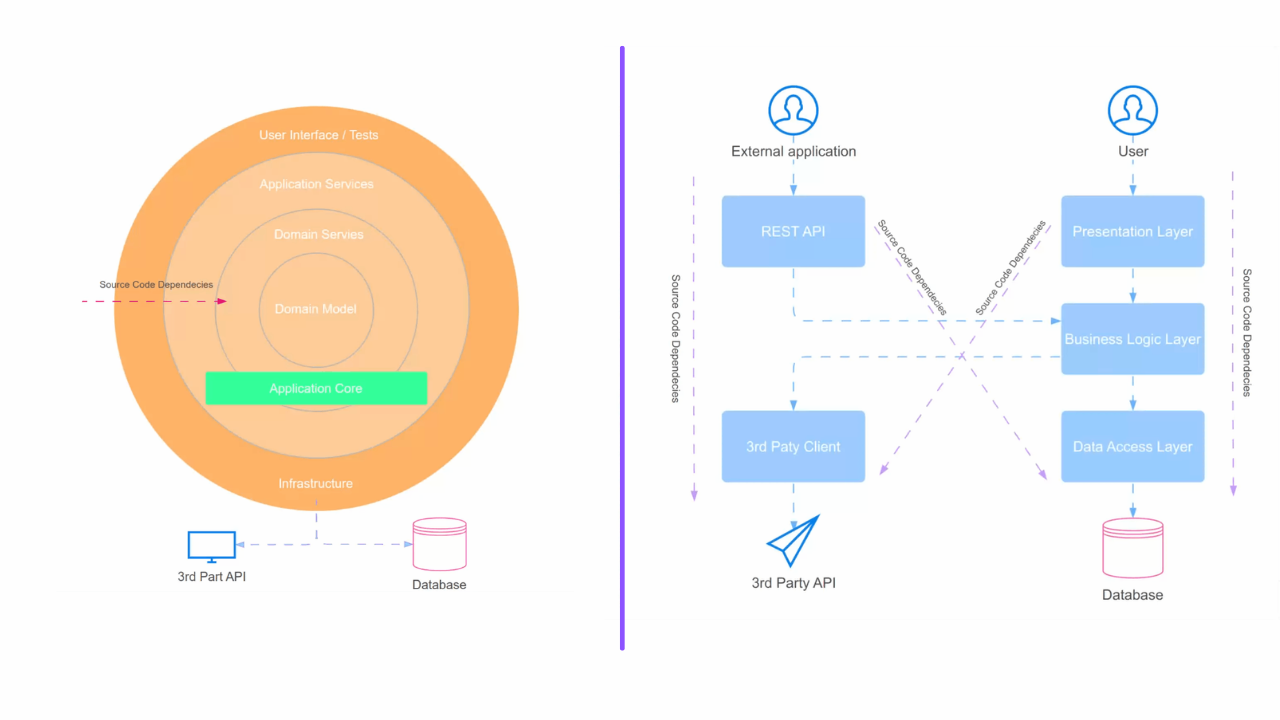In software architecture, selecting an appropriate design pattern is crucial for building maintainable, testable, and scalable applications. Two prominent architectural styles are Layered Architecture and Onion Architecture. Understanding their distinctions and suitable applications can guide developers in making informed decisions.
Layered Architecture
Layered Architecture, often referred to as N-tier architecture, organizes an application into horizontal layers, each with a specific responsibility. A typical configuration includes:
- Presentation Layer: Manages user interface components and handles user interactions.
- Business Logic Layer: Contains the core functionality, processing commands, making logical decisions, and performing calculations.
- Data Access Layer: Responsible for accessing data sources, such as databases or external services, and performing CRUD (Create, Read, Update, Delete) operations.
Each layer communicates primarily with the layer directly below it, creating a unidirectional flow of control. This separation of concerns enhances modularity and allows for independent development and testing of each layer.
Onion Architecture
Onion Architecture, introduced by Jeffrey Palermo, emphasizes the centrality of the application’s core domain and builds outward in concentric layers. The primary layers include:
- Domain Layer: Encapsulates business logic and domain entities, representing the core of the application.
- Application Layer: Coordinates application activities, acting as a mediator between the domain and external layers without implementing business rules.
- Infrastructure Layer: Contains external dependencies, such as databases, user interfaces, and external services.
In this architecture, dependencies are directed toward the center, ensuring that the core domain remains isolated from external concerns. This design promotes loose coupling and enhances testability by allowing the core logic to operate independently of infrastructure and frameworks.
Key Differences
- Dependency Direction:
- Layered Architecture: Dependencies typically flow inward, with each layer depending on the one below it. This can lead to tight coupling between layers, especially if higher layers directly depend on the implementations of lower layers.
- Onion Architecture: Dependencies point inward toward the core domain. Outer layers depend on inner layers through interfaces or abstractions, ensuring that changes in external systems do not affect the core logic.
- Separation of Concerns:
- Layered Architecture: While it separates concerns into different layers, the coupling between layers can become tight, especially if the business logic depends directly on data access implementations. This can make the system less flexible and harder to test in isolation.
- Onion Architecture: Enforces a strict separation of concerns by isolating the core domain from external factors. This isolation facilitates easier testing and maintenance, as the core logic is unaffected by changes in the infrastructure.
- Flexibility and Maintainability:
- Layered Architecture: Modifications can be challenging, particularly when business logic is intertwined with data access code. This entanglement can lead to a rigid structure that is difficult to adapt to changing requirements.
- Onion Architecture: The loose coupling and clear separation of concerns result in a more adaptable and maintainable system. Changes in external layers, such as swapping a database or modifying the user interface, have minimal impact on the core domain.
Use Cases
- Layered Architecture:
- Suitable for applications with straightforward requirements and a clear separation of concerns.
- Effective in scenarios where the application is unlikely to undergo significant changes or require high scalability.
- Commonly used in traditional enterprise applications where a standard approach is sufficient.
- Onion Architecture:
- Ideal for complex, enterprise-level applications where business logic is central and subject to frequent changes.
- Beneficial when aiming for high testability, scalability, and independence from external frameworks or technologies.
- Suitable for systems that require integration with multiple external services or databases, as it allows for easier adaptation to different infrastructures.
Conclusion
Choosing between Layered and Onion Architecture depends on the specific needs and complexity of your project. Layered Architecture may suffice for simpler applications with stable requirements. However, for complex systems that demand flexibility, scalability, and a focus on core business logic, Onion Architecture offers significant advantages by promoting a clear separation of concerns and ensuring that the core domain remains isolated from external influences.
